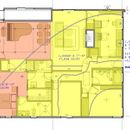I’m remodeling a home in Seattle (1500sf, slab on grade), including air source heat pump, new siding and new windows/doors, and debating whether to include an HRV, and if so which one. Top of diagram is North.
l live alone, and the main bedroom connects to the living area with a double width door which is usually open, and there are two openings to the kitchen. So that’s a fairly large semi-contiguous space. The white area on the North (top) is a storage area, not part of the conditioned space.
I received a proposal for a Lifebreath system, with some shared ducting (I think it might have been what this site calls a hybrid system). I’m concerned that enhancing it to separate ducting will be cost-prohibitive. I’m waiting for a Zehnder quote, but expecting it to be cost-prohibitive too.
I find the Lunos system (3 pairs) quite appealing, even though I do have L-shaped attic space over the bedrooms, kitchen and dining area. The living room is mostly under flat roof, but there’s room to have ducting to the living room in the center of the house.
A potential obstacle with Lunos is that the North side of the house is close to the lot line, so there may be code issues with in/outlets on that side. Lots of windows and sliding doors to the West (left), which leaves the living/dining area without a good place to place units.
I’m wondering if there are limits to the length between paired units. If not, I could imagine distributing 3 units on the East side (kitchen, hallway, bedroom for example) and South side (main bedroom, other 2 bedrooms). Something like I drew on the attached layout.
Suggestions appreciated. Thanks in advance.











Replies
Richard,
I'll give your post a bump and ask a couple of questions. Are you air sealing as part of the remodel. (That's where much of the bang-for-the-buck efficiency benefits are found.) I ask because ventilation becomes more critical when the house is tight. Have you completed a blower door test to capture some data on your home?
I'm definitely hoping for a relatively air-tight home, but I don't have a number in mind, and we're not opening the walls from the inside. I actually did a blower door many test years ago, and was thinking we should do one at the end of this project (after windows etc). Is there some reason to do one before we start? Thanks for the bump.
Richard,
The idea is to establish a baseline and then using it to plan your updates. For example, if your house is not terribly leaky, you could avoid some of the more invasive and expensive projects people often put on their to-do list. In your case, you don't know how much ventilation is enough at this point.
Can you find the results of that previous test? Is that a gas-fired stove in your kitchen? If you are concerned about indoor air quality, you should consider giving it the heave-ho.
Yes it's a gas-fired stove, and switching to induction is definitely under consideration. There is also a gas fireplace and gas-powered on-demand water heater. The later likely to be replaced with something electic/heat pump like a Rheem. The house is cold (poor insulation, slab on grade) so comfort and low heating costs are drivers, but obviously if I'm improving the envelope anyway, air tightness and HRVs come into play. In other words, indoor air quality was not the primary goal, but it makes sense to think about.
FWIW I love induction! My new home is obviously larger than yours but my Zehnder quote installed is $27k. 43% of that is installation. So keep that in mind when you get your quote. We're ending up doing a lot of things ourselves because of contractor gouging; I have to watch some videos and see how difficult it is to install the Zehnder unit ourselves. I can't believe they want over $6000 just to set the unit and duct it to the outside. That doesn't include running all the tubing or commissioning.
Yes, I read elsewhere to budget 50% for the installation. Good luck with your project!
Every new home or deep renovation should get mechanical ventilation. In most cases that means ERV or HRV. Size it based on no leakage, because even a leaky house won't leak much in still air, and even when it is leaking it might not be going where you want it.
Extract from bathrooms, kitchen and utility/laundry rooms. Supply to bedrooms and main living areas. You don't need dedicated bath fans if you have ERV extraction there.
谢谢。我有现有的浴室的粉丝,if I can find a suitable layout for Lunos, I think I'd have 3 pairs in bedrooms and living areas, and retain the existing bathroom fans, possibly adding one in the laundry room.
Mechanical ventilation with an ERV/HRV is all about air quality. Otherwise, how do you justify the upfront cost and energy hit? If you're renovating, now is the time to run the 220 VAC circuits for any new electrical appliances. (FWIW. I've had two induction cooktops and much prefer them to the gas equivalent.)
Also...
If you're doing new windows and siding, be sure to have a strategy for prepping any openings and managing bulk water. And if you are replacing siding, this is a great opportunity to add some exterior insulation.
In other words, you may want to step back and think through your plans.
Thanks for all the comments. A centralized system with separate ducting seems ideal, I just don't think I can justify Zehnder-level costs, but I will continue to explore other options, including the ductless Lunos, and will re-read the articles about hybrid ducting.
Update: my Zehnder quote came in at around $5800 (pre-installation) for a ComfoAir 200. A bit better than I expected - I guess my house is small enough that a 350 wasn't needed. I think I also have a viable layout for a 3-pair Lunos system.